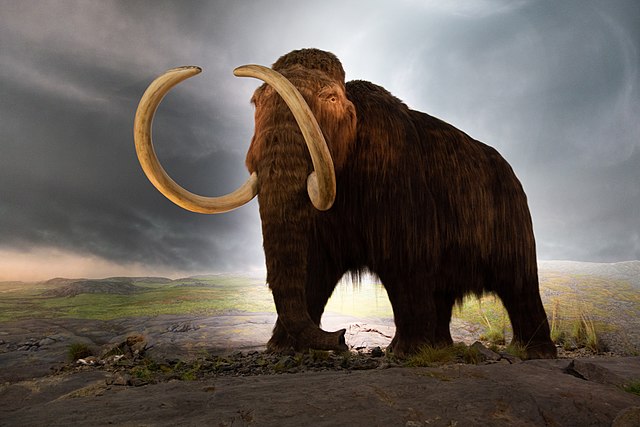
When did the last woolly mammoth disappear? A population of woolly mammoths survived on Wrangel Island until about 2000 BC, about 500 years after the Great Pyramid of Giza was built.
Woolly mammoths appeared in Siberia about 700,000 years ago. They were the same size as a modern African Elephant: up to 3.4 m at the shoulder and about 6 tons, but they were adapted for cold. They had a layer of thick, long hair, about 30 cm long, over a shorter, denser insulating layer. They had small ears and a short tail to reduce heat loss and combat frostbite. African elephants have large ears because a large surface area allows them to lose heat more easily. Woolly mammoths had small ears so that they didn’t lose heat. They had much longer tusks than modern elephants, usually reaching about 2.5 m long.
More is known about woolly mammoths than probably any other prehistoric animal because so many bones have been found. Also, a number of animals frozen in the permafrost above the Arctic Circle have been discovered. Some of these animals even still have food in their stomachs.
Woolly mammoths spread out across northern Asia, northern Europe, and northern America. They were able to get to all of these continents because the seas between them were frozen during the ice ages. They lived on grassy steppes. However, remains have been found from southern China and Spain, indicating that they lived in milder areas as well.
Starting from approximately 40,000 years ago, nearly all of the Woolly mammoths began to die out. In this period, many animals died out and it is known as the quaternary extinction event. It is one of the big six extinction events. There are numerous theories as to why this occurred, but no one answer. The theories range from climate change, over hunting by humans, a meteor impact, and disease. There are arguments for and against every theory. It is true that the world had started to warm up, and mammoths were adapted for cold weather, but we know that mammoths lived further south, so we know they could probably adapt. We also know that there was a rapid increase of humans around this time, but there is very little evidence to say that early humans hunted mammoths. There are 500 cave paintings that show woolly mammoths, but only a few of these paintings show mammoths being hunted, and only one woolly mammoth has been found with a spear blade in it. Evidence has been found in Mexico that shows early humans drove mammoths into pits and then killed them. It was only later, when humans developed more advanced weaponry and techniques, that they could have hunted mammoths in larger numbers, but there is no evidence that they did.
By 10000 BC, all mammoths had disappeared, except for small populations of mammoths on islands, cut off as the seas started to rise at the end of the ice age. The population that lasted the longest was on a remote Arctic island called Wrangel Island. It is about 200 km to the north of the Russian mainland. This small population of mammoths was cut off and lived on its own for thousands of years.
Because they were isolated, they began to suffer from genetic mutations that only worsened as time went on. They had a lowered ability to detect scents. This would have caused problems because most animals use scents to mark territory. They lost their inner insulating fur layer, making them less able to survive cold winters. They had neurological and fertility problems as well.
The last mammoths disappeared from the island in about 2000 BC. That coincides with the time humans started to inhabit the island, so it is very likely that they were hunted to extinction by the people that lived on the island. So, while the Great Pyramid of Giza was being built in Egypt, the last woolly mammoths were being killed on an island in the Arctic Ocean.
There is some talk of trying to bring the woolly mammoth back. Because many frozen mammoth carcasses have been found, scientists have woolly mammoth DNA. There are three methods that are being considered. The first is to take the nucleus from the egg cell of a female elephant and replace it with the nucleus taken from woolly mammoth tissue. The second is to take sperm from a male mammoth carcass and artificially inseminate a modern elephant. The third method is to replace the genes of a modern elephant with genes from the mammoth. All of these methods have too many problems to actually work at the moment, but they may do someday. And this is what I learned today.
Sources
https://www.science.org/content/article/last-lonely-woolly-mammoths-faced-genomic-meltdown
https://www.livescience.com/woolly-mammoth-genetic-problems.html
https://en.wikipedia.org/wiki/Woolly_mammoth
https://en.wikipedia.org/wiki/Wrangel_Island
https://www.ncbi.nlm.nih.gov/pmc/articles/PMC4439331/
https://www.sciencedaily.com/releases/2019/10/191007081750.htm
